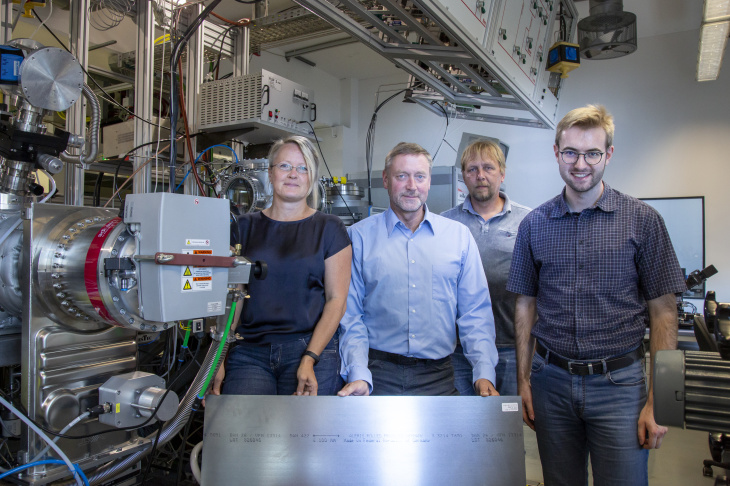
- Novel barrier layers for inexpensive and high-strength steels in hydrogen technology
The research project “H2BS – Novel Barrier Layers for Inexpensive and High-Strength Steels in Hydrogen Technology” is setting new milestones in hydrogen technology.
Hydrogen is one of the main players in the energy transition. The ability to generate it from water and renewable energy sources such as wind and solar with the help of electrolysers makes it the ideal green energy store. Hydrogen can also be partially stored and distributed in the existing gas network. As a fuel for emission-free fuel cell vehicles, hydrogen has become an integral part of future mobility. Due to its relatively low energy density, hydrogen must be stored and transported in gaseous form under high pressure or in liquid form. In order to establish hydrogen as the energy source of the future, innovative solutions for safe and efficient storage and handling under the conditions mentioned are required. Safe, volume-efficient,
Highly alloyed steels, carbon or polymer-based materials are mainly used in existing tanks, pipes and fittings. However, these are either expensive or permeable and involve high fuel loss rates. Less expensive steels are subject to the phenomenon of hydrogen-related corrosion. Hydrogen penetrates the steel structure and leads to embrittlement and cracking. This means that they are currently unsuitable for storing hydrogen. This is exactly where the scientists from the three research institutions come in. Over a period of 24 months, they are working together on the development of plasma processes for the creation of so-called barrier layers that are intended to prevent hydrogen from penetrating the steel surface.
As part of the project, INP is developing vacuum and atmospheric pressure-based plasma processes for coating and treating the surface. “The challenge is to create a coating with the properties required for hydrogen storage,” explains project manager Dr. Angela Kruth, head of the research group “Materials for Energy Technology” at INP. The result must “withstand the significant requirements such as extreme pressure ranges under which hydrogen is used today, for example in mobility”. In investigations based on state-of-the-art structural analysis using electron microscopy from the MPIE in Düsseldorf, the first results of the barrier coating are already visible on an atomic scale.
Storage in metal hydrides

The HZG is researching the storage of hydrogen in metal hydrides. Photo: HZG / Tim Peters
A special focus of the joint research work is the storage of hydrogen in metal hydrides – a promising alternative to high pressure and cold tanks. By combining metals with hydrogen, the so-called metal hydrides, an astonishing amount of the gas can be absorbed, so that twice as much hydrogen can be stored in a container of the same size. The Helmholtz Center in Geesthacht is a leader in the field of metal hydride development. In the HZG’s Hydrogen Technology Center, the effectiveness of the coating against embrittlement can be tested and evaluated under real conditions.
New ways for hydrogen technology

Dr. Angela Kruth, Prof. Klaus-Dieter Weltmann, Uwe Lindemann and Dr. Marcel Wetegrove (from left to right) with steel material for the future H2 infrastructure. Photo: INP
“With this interdisciplinary network of experts, we are pleased to open up new avenues for hydrogen technology,” said Dr. Kruth. At the end of the project, the basics for a coating process for the production of barrier layers with defined properties should be available, which adequately protect the various steel materials against the diffusion of hydrogen in and out, and thus successfully prevent their embrittlement, in accordance with the planned operating conditions. In a follow-up project, these coating technologies will then be optimized for concrete, real components of hydrogen technology, both for stationary storage tanks as well as for maritime mobility and other hydrogen systems.
The project is supported by an industry committee with experts from the automotive industry and mechanical engineering and is funded by the Federal Ministry for Economic Affairs and Energy through the Working Group of Industrial Research Associations (AiF) as part of the program for the promotion of industrial community research and development (IGF).
Contact Person for Further Details
Scientific contact at the HZG
Dr. Klaus Taube, Institute for Materials Research
Helmholtz-Zentrum Geesthacht
Tel: +49 (0) 4152/87 25 41
Read the most up to date Fuel Cell and Hydrogen Industry news at FuelCellsWorks




